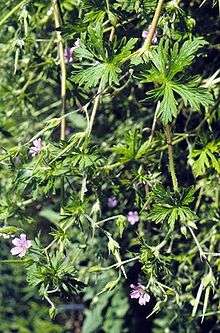Geranium bicknellii
| Geranium bicknellii | |
|---|---|
 | |
| Scientific classification | |
| Kingdom: | Plantae |
| (unranked): | Angiosperms |
| (unranked): | Eudicots |
| (unranked): | Rosids |
| Order: | Geraniales |
| Family: | Geraniaceae |
| Genus: | Geranium |
| Species: | G. bicknellii |
| Binomial name | |
| Geranium bicknellii Britton | |
Geranium bicknellii is a species of geranium known by the common names Bicknell's cranesbill and northern cranesbill. It is native to much of the northern half of North America, where it can be found in a number of forest and woodland habitats. This is an annual or biennial herb which grows hairy stems up to about half a meter long. It may be erect or lie near the ground. Each leaf is several centimeters long and wide and is divided into several lobes, each of which may have smaller lobes or teeth. Flowers grow singly or in pairs and have pointed sepals and small lavender petals, each with a notch in the tip. The fruit has a rounded body with a long, straight style about 2 centimeters in length and tipped with a small beak.
Geranium bicknellii is a fire-adapted species, occurring most abundantly in recently burned forests. The seeds remain dormant while buried in the forest floor, sometimes for centuries, until a fire removes the organic litter and exposes the seeds to sunlight. The geraniums will germinate, bloom, and set seed profusely for several years after the fire, until other plants grow large enough to shade them out. The new seeds will then lie dormant in the soil, waiting for the next fire.[1]
References
- ↑ Reeves, Sonja L. (2007). "Geranium bicknellii". Fire Effects Information System. U.S. Department of Agriculture, Forest Service, Rocky Mountain Research Station, Fire Sciences Laboratory. Retrieved September 23, 2011.
External links
- Jepson Manual Treatment
- USDA Plants Profile
- Photo gallery
- Frelich, Lee E., May-June 2008, Minnesota Profile: Bicknell's geranium (Geranium bicknellii), Minnesota Conservation Volunteer
- Portland Plant List